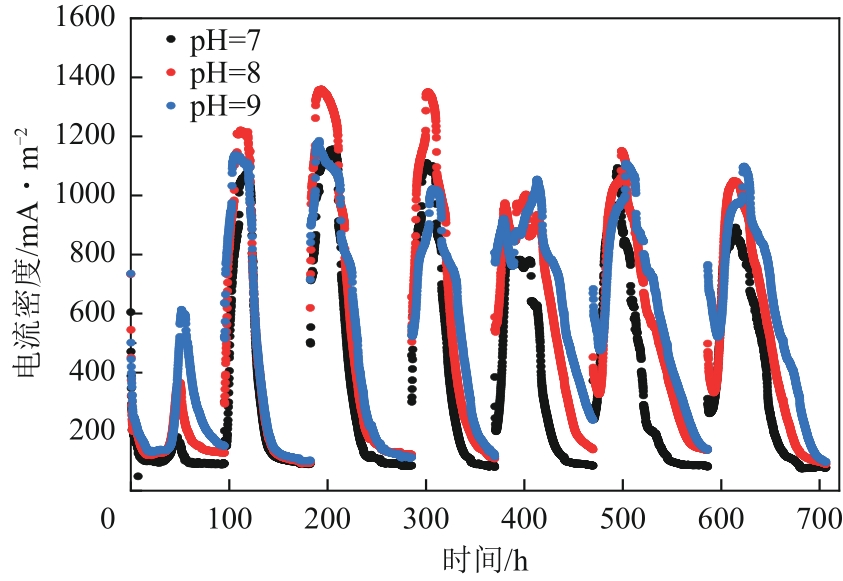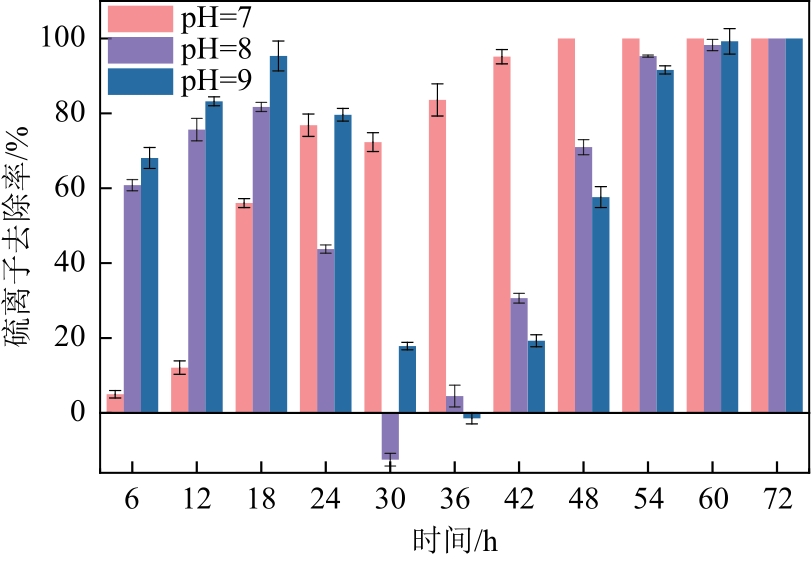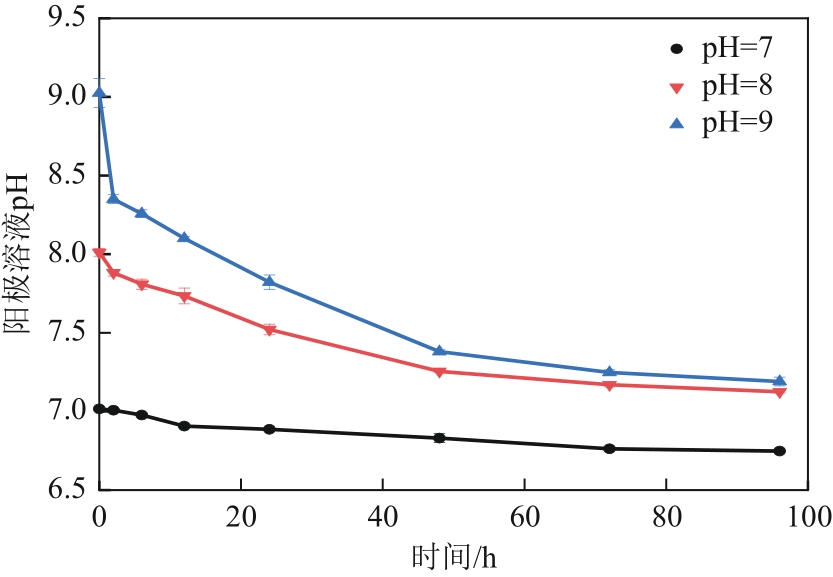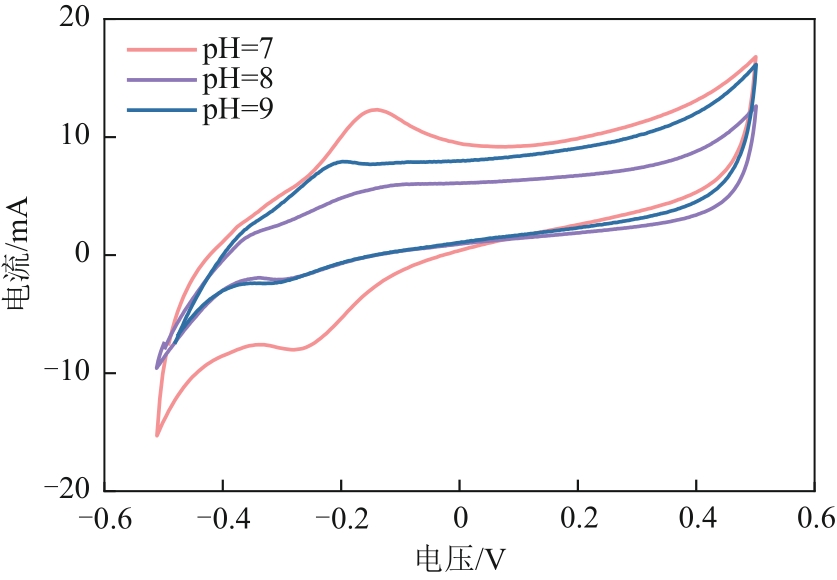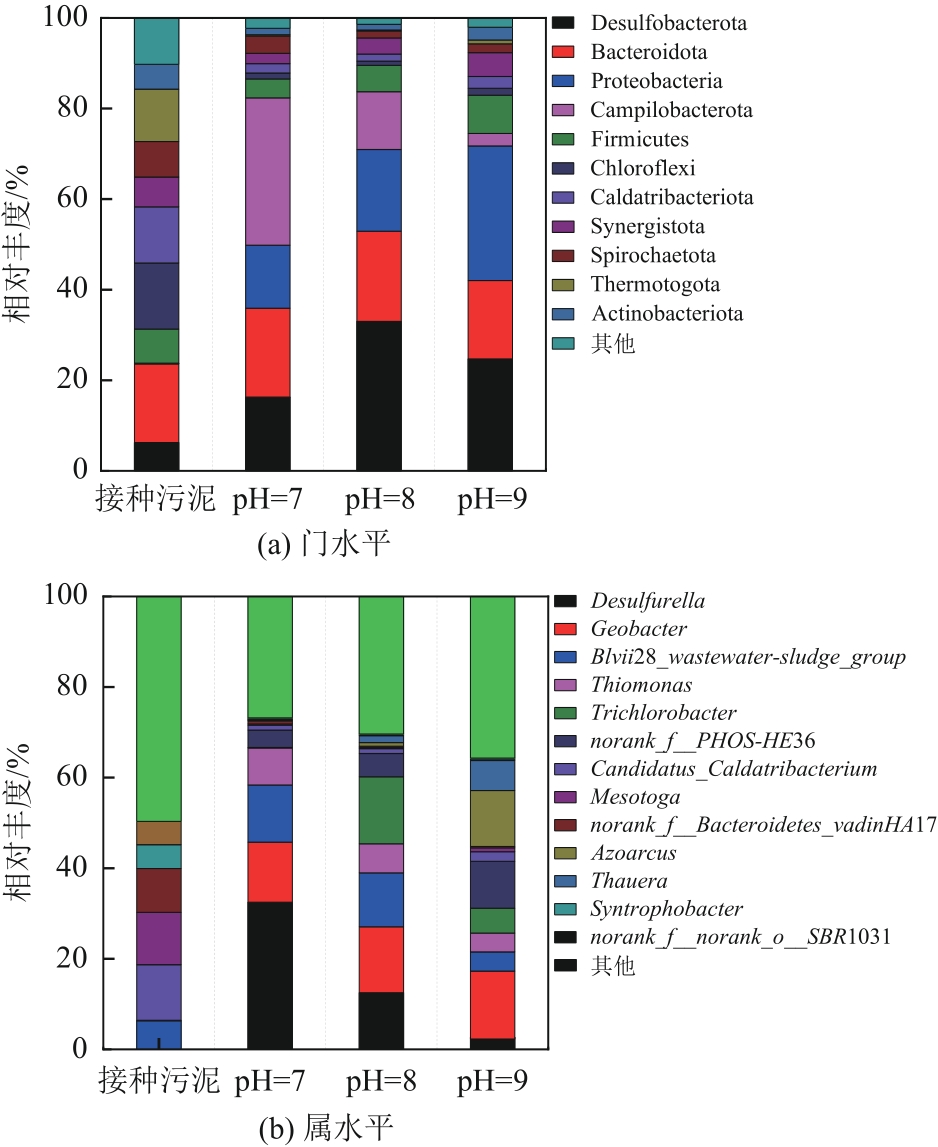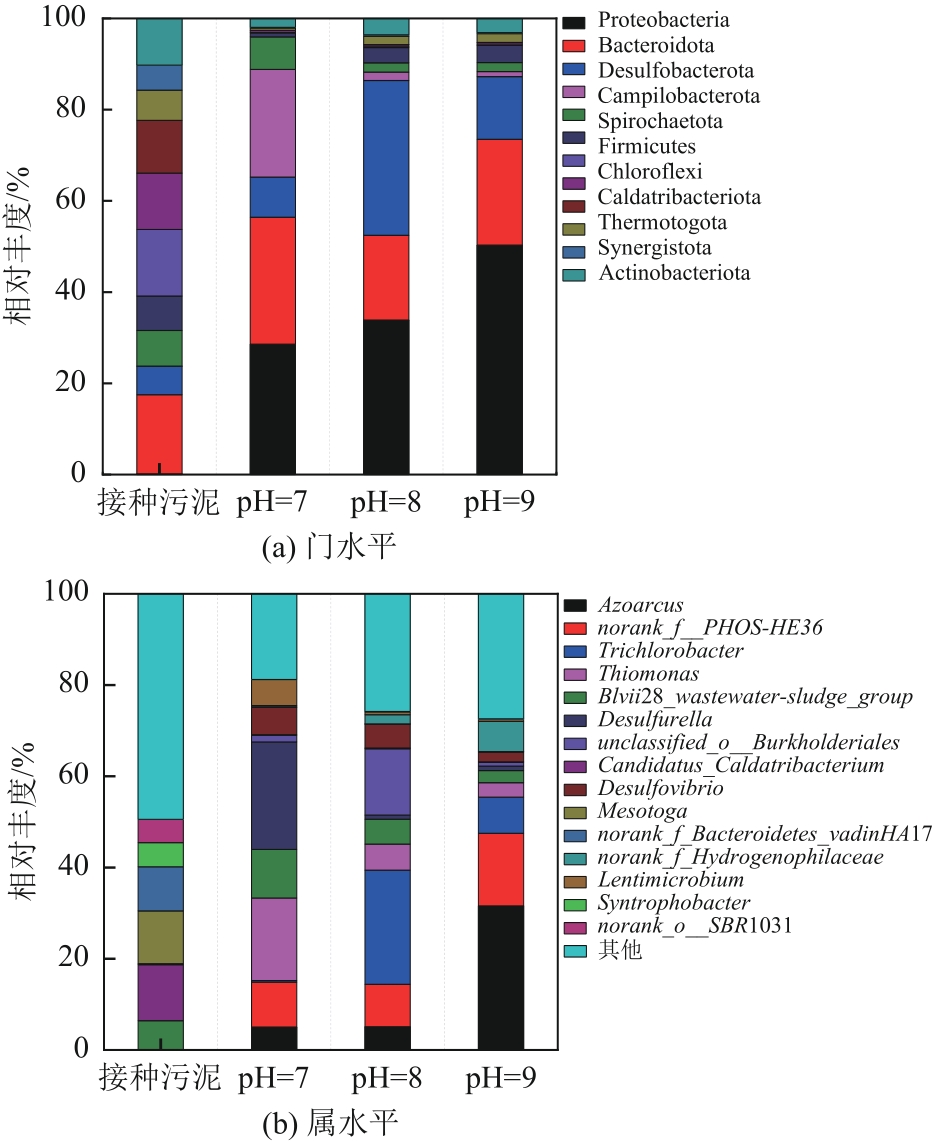化工进展 ›› 2024, Vol. 43 ›› Issue (4): 2219-2225.DOI: 10.16085/j.issn.1000-6613.2023-0686
• 资源与环境化工 • 上一篇
初始pH调控对MEC脱硫性能的影响及其微生物作用机制
郭萌1,2( ), 郭美欣1,2, 魏思佳1,2, 赵玉娇1,2, 贾璇1,2(
), 郭美欣1,2, 魏思佳1,2, 赵玉娇1,2, 贾璇1,2( )
)
- 1.北京工商大学国家环境保护食品链污染防治重点实验室,北京 100048
2.北京工商大学中国轻工业清洁生产和资源综合利用重点实验室,北京 100048
-
收稿日期:2023-04-26修回日期:2023-05-30出版日期:2024-04-15发布日期:2024-05-13 -
通讯作者:贾璇 -
作者简介:郭萌(1999—),女,硕士研究生,研究方向为有机废弃物高值化。E-mail:754346758@qq.com。 -
基金资助:国家重点研发计划(2019YFD1100304)
Effect of pH on MEC desulfurization performance and microbial mechanism of action
GUO Meng1,2( ), GUO Meixin1,2, WEI Sijia1,2, ZHAO Yujiao1,2, JIA Xuan1,2(
), GUO Meixin1,2, WEI Sijia1,2, ZHAO Yujiao1,2, JIA Xuan1,2( )
)
- 1.Beijing Technology and Business University, State Environmental Protection Key Laboratory of Food Chain Pollution Control, Beijing 100048, China
2.Beijing Technology and Business University, Key Laboratory of Cleaner Production and Integrated Resource Utilization of China National Light Industry, Beijing 100048, China
-
Received:2023-04-26Revised:2023-05-30Online:2024-04-15Published:2024-05-13 -
Contact:JIA Xuan
摘要:
采用微生物电解池(MEC)工艺,在阳极电活性微生物的协同作用下实现硫化物的脱除,是沼气脱硫新工艺和研究热点。针对长期运行的脱硫MEC工艺,由于非特异性阳离子竞争使阳极产生的质子向阴极转移受阻,造成MEC脱硫效率低、稳定运行难,本研究采用不同初始pH调控脱硫MEC的质子平衡,通过脱硫性能、电化学性能和微生物动力学解析,阐明pH调控对MEC脱硫性能的影响和微生物作用机制。结果表明,初始pH在7~9时均可形成稳定且具有高效脱硫功能的阳极生物膜,最大电流密度相近,脱硫效率均达95%以上,COD去除率80%以上。与初始pH为8、9相比,初始pH为7时,脱硫过程pH波动最小,MEC运行稳定,S2-去除最高达100%;阳极生物膜的氧化还原峰最显著,质子与电子转移速率加快;优势微生物Thiomonas与Desulfovibrio丰度更高,主要参与硫化物的氧化脱除。可见,通过脱硫MEC阳极室初始pH的调控,可有效提高MEC脱硫工艺性能和运行稳定性,为沼气微生物电化学脱硫的应用提供技术支撑。
中图分类号:
引用本文
郭萌, 郭美欣, 魏思佳, 赵玉娇, 贾璇. 初始pH调控对MEC脱硫性能的影响及其微生物作用机制[J]. 化工进展, 2024, 43(4): 2219-2225.
GUO Meng, GUO Meixin, WEI Sijia, ZHAO Yujiao, JIA Xuan. Effect of pH on MEC desulfurization performance and microbial mechanism of action[J]. Chemical Industry and Engineering Progress, 2024, 43(4): 2219-2225.
| 项目 | Shannon | Simpson | Ace | Chao | 覆盖率/% |
|---|---|---|---|---|---|
| 接种污泥 | 3.91 | 0.05 | 551.94 | 542.71 | 99.81 |
| 阳极生物膜 | |||||
| pH=7 | 2.82 | 0.15 | 575.03 | 521.63 | 99.75 |
| pH=8 | 3.28 | 0.08 | 502.02 | 452.53 | 99.72 |
| pH=9 | 3.56 | 0.06 | 461.42 | 464.33 | 99.69 |
| 阳极溶液 | |||||
| pH=7 | 2.68 | 0.12 | 269.98 | 264.09 | 99.84 |
| pH=8 | 3.06 | 0.10 | 375.12 | 314.68 | 99.81 |
| pH=9 | 2.84 | 0.14 | 295.14 | 286.67 | 99.88 |
表1 污泥、阳极生物膜、阳极液微生物群落Alpha多样性比较
| 项目 | Shannon | Simpson | Ace | Chao | 覆盖率/% |
|---|---|---|---|---|---|
| 接种污泥 | 3.91 | 0.05 | 551.94 | 542.71 | 99.81 |
| 阳极生物膜 | |||||
| pH=7 | 2.82 | 0.15 | 575.03 | 521.63 | 99.75 |
| pH=8 | 3.28 | 0.08 | 502.02 | 452.53 | 99.72 |
| pH=9 | 3.56 | 0.06 | 461.42 | 464.33 | 99.69 |
| 阳极溶液 | |||||
| pH=7 | 2.68 | 0.12 | 269.98 | 264.09 | 99.84 |
| pH=8 | 3.06 | 0.10 | 375.12 | 314.68 | 99.81 |
| pH=9 | 2.84 | 0.14 | 295.14 | 286.67 | 99.88 |
| 1 | VILLADSEN Sebastian NIS BAY, AHRENSBERG KAAB Malene, PLETH NIELSEN Lars, et al. New electroscrubbing process for desulfurization[J]. Separation and Purification Technology, 2021, 278: 119552. |
| 2 | XUE Shengrong, SONG Jinghui, WANG Xiaojiao, et al. A systematic comparison of biogas development and related policies between China and Europe and corresponding insights[J]. Renewable and Sustainable Energy Reviews, 2020, 117: 109474. |
| 3 | 付永猛, 夏亚龙, 雷成军, 等. 乳业废水沼气利用与碳减排的工程探索[J]. 低碳世界, 2022, 12(1): 46-48, 76. |
| FU Yongmeng, XIA Yalong, LEI Chengjun, et al. Engineering exploration on biogas utilization and carbon emission reduction of dairy wastewater[J]. Low Carbon World, 2022, 12(1): 46-48, 76. | |
| 4 | 楼毕觉. 微氧连续导入厌氧发酵系统实现H2S原位脱除的研究[D]. 杭州: 浙江工业大学, 2020. |
| LOU Bijue. In-situ removal of H2S by continuous introduction of micro-oxygen into anaerobic fermentation system[D]. Hangzhou: Zhejiang University of Technology, 2020. | |
| 5 | 闫灏. 基于碱化学吸收法的沼气化学与生物组合脱硫技术研究[D]. 北京: 北京化工大学, 2020. |
| YAN Hao. Desulfurization of biogas through alkali chemiscal absorption combined and biological methods[D]. Beijing: Beijing University of Chemical Technology, 2020. | |
| 6 | 欧阳力. 生物滴滤塔对沼气中硫化氢的去除效能研究[D]. 哈尔滨: 哈尔滨工业大学, 2011. |
| OUYANG Li. Research on the removalefficiency of hydrogen sulfide from biogas in the biotrickling filter[D]. Harbin: Harbin Institute of Technology, 2011. | |
| 7 | 姜茹. 沼气中硫化氢的脱除技术研究[D]. 南京: 南京大学, 2011. |
| JIANG Ru. Study on removal technology of H2S in biogas[D]. Nanjing: Nanjing University, 2011. | |
| 8 | 崔磊. 电化学法脱除溶液中硫离子的研究[D]. 成都: 西南石油大学, 2012. |
| CUI Lei. Study on removal of sulfur ions from solution by electrochemical method[D]. Chengdu: Southwest Petroleum University, 2012. | |
| 9 | SHEN Hongyan, ZHANG Zhitao, CHEN Zheng, et al. A novel bioelectrochemical strategy for efficient treatment of saline-alkaline and oligotrophic sulfate wastewater mediated by bacterial electron shuttling[J]. Journal of Water Process Engineering, 2023, 51: 103449. |
| 10 | DING Aqiang, YANG Yu, SUN Guodong, et al. Impact of applied voltage on methane generation and microbial activities in an anaerobic microbial electrolysis cell (MEC)[J]. Chemical Engineering Journal, 2016, 283: 260-265. |
| 11 | SULONEN Mira L K, BAEZA Juan Antonio, GABRIEL David, et al. Optimisation of the operational parameters for a comprehensive bioelectrochemical treatment of acid mine drainage[J]. Journal of Hazardous Materials, 2021, 409: 124944. |
| 12 | YUAN Ye, CHENG Haoyi, CHEN Fan, et al. Enhanced methane production by alleviating sulfide inhibition with a microbial electrolysis coupled anaerobic digestion reactor[J]. Environment International, 2020, 136: 105503. |
| 13 | NI Gaofeng, HARNAWAN Pebrianto, SEIDEL Laura, et al. Haloalkaliphilic microorganisms assist sulfide removal in a microbial electrolysis cell[J]. Journal of Hazardous Materials, 2019, 363: 197-204. |
| 14 | DONG Zhishuai, ZHAO Yu, FAN Lei, et al. Simultaneous sulfide removal and hydrogen production in a microbial electrolysis cell[J]. International Journal of Electrochemical Science, 2017, 12(11): 10553-10566. |
| 15 | DYKSTRA Christy M, PAVLOSTATHIS Spyros G. Hydrogen sulfide affects the performance of a methanogenic bioelectrochemical system used for biogas upgrading[J]. Water Research, 2021, 200: 117268. |
| 16 | POZO Guillermo, LU Yang, PONGY Sebastien, et al. Selective cathodic microbial biofilm retention allows a high current-to-sulfide efficiency in sulfate-reducing microbial electrolysis cells[J]. Bioelectrochemistry, 2017, 118: 62-69. |
| 17 | ZEPPILLI Marco, PAIANO Paola, TORRES Cesar, et al. A critical evaluation of the pH split and associated effects in bioelectrochemical processes[J]. Chemical Engineering Journal, 2021, 422: 130155. |
| 18 | KOOMSON Desmond Ato, HUANG Jingyu, LI Guang, et al. Comparative studies of recirculatory microbial desalination cell-microbial electrolysis cell coupled systems[J]. Membranes, 2021, 11(9): 661. |
| 19 | 许坤德, 李建昌, 邵琼丽, 等. 初始pH值对MEC阳极膜的产氢性能和微生物群落的影响[J]. 化学研究与应用, 2020, 32(12): 2224-2230. |
| XU Kunde, LI Jianchang, SHAO Qiongli, et al. Effect of initial pH on the performance and microbial community of MEC anode biofilms[J]. Chemical Research and Application, 2020, 32(12): 2224-2230. | |
| 20 | PATIL Sunil A, HARNISCH Falk, KOCH Christin, et al. Electroactive mixed culture derived biofilms in microbial bioelectrochemical systems: The role of pH on biofilm formation, performance and composition[J]. Bioresource Technology, 2011, 102(20): 9683-9690. |
| 21 | YANG Yuli, QIN Mohan, YANG Xiaoli, et al. Enhancing hydrogen production in microbial electrolysis cells by in situ hydrogen oxidation for self-buffering pH through periodic polarity reversal[J]. Journal of Power Sources, 2017, 347: 21-28. |
| 22 | ZHEN Guangyin, LU Xueqin, KUMAR Gopalakrishnan, et al. Microbial electrolysis cell platform for simultaneous waste biorefinery and clean electrofuels generation: Current situation, challenges and future perspectives[J]. Progress in Energy and Combustion Science, 2017, 63: 119-145. |
| 23 | Joo-Youn NAM, LOGAN Bruce E. Optimization of catholyte concentration and anolyte pHs in two chamber microbial electrolysis cells[J]. International Journal of Hydrogen Energy, 2012, 37(24): 18622-18628. |
| 24 | WANG Yongzhong, ZHANG Lei, XU Tengfei, et al. Influence of initial anolyte pH and temperature on hydrogen production through simultaneous saccharification and fermentation of lignocellulose in microbial electrolysis cell[J]. International Journal of Hydrogen Energy, 2017, 42(36): 22663-22670. |
| 25 | NGUYEN Phan Khanh Thinh, KIM Jihyeon, Gautam DAS, et al. Optimization of simultaneous dark fermentation and microbial electrolysis cell for hydrogen production from macroalgae using response surface methodology[J]. Biochemical Engineering Journal, 2021, 171: 108029. |
| 26 | LUO Shuai, LIU Fubin, FU Boya, et al. Onset investigation on dynamic change of biohythane generation and microbial structure in dual-chamber versus single-chamber microbial electrolysis cells[J]. Water Research, 2021, 201: 117326. |
| 27 | 赵玉娇, 朱雨森, 郭美欣, 等. 脱硫MEC的硫价态变化与微生物群落演替规律[J]. 环境工程学报, 2022, 16(1): 264-271. |
| ZHAO Yujiao, ZHU Yusen, GUO Meixin, et al. Sulfur valence variety and microbial community succession of desulphurization MEC[J]. Chinese Journal of Environmental Engineering, 2022, 16(1): 264-271. | |
| 28 | WANG Bo, LIU Wenzong, ZHANG Yifeng, et al. Bioenergy recovery from wastewater accelerated by solar power: Intermittent electro-driving regulation and capacitive storage in biomass[J]. Water Research, 2020, 175: 115696. |
| 29 | 国家环境保护总局. 水质 硫化物的测定 亚甲基蓝分光光度法: [S]. 北京: 中国标准出版社, 1996. |
| State Environmental Protection Administration of the People's Republic of China. Water quality-Determination of sulfide-Methylene blue spectrophotometric method: [S]. Beijing: Standards Press of China, 1996. | |
| 30 | 中华人民共和国环境保护部. 水质 化学需氧量的测定 快速消解分光光度法: [S]. 北京: 中国环境科学出版社, 2008. |
| Ministry of Environmental Protection of the People's Republic of China. Water quality-Determination of the chemical oxygen demand-Fast digestion-Spectrophotometric method: [S]. Beijing: China Environmental Science Press, 2008. | |
| 31 | YU Jiangnan, HUANG Zhenxing, WU Peng, et al. Performance and microbial characterization of two-stage caproate fermentation from fruit and vegetable waste via anaerobic microbial consortia[J]. Bioresource Technology, 2019, 284: 398-405. |
| 32 | HE Kuanchang, LI Wei, TANG Longxiang, et al. Suppressing methane production to boost high-purity hydrogen production in microbial electrolysis cells[J]. Environmental Science & Technology, 2022, 56(17): 11931-11951. |
| 33 | Enric BLÁZQUEZ, GABRIEL David, BAEZA Juan Antonio, et al. Treatment of high-strength sulfate wastewater using an autotrophic biocathode in view of elemental sulfur recovery[J]. Water Research, 2016, 105: 395-405. |
| 34 | CHENG Shaoan, LOGAN Bruce E. Sustainable and efficient biohydrogen production via electrohydrogenesis[J]. Proceedings of the National Academy of Sciences of the United States of America, 2007, 104(47): 18871-18873. |
| 35 | ZHANG Shuang, GUAN Weijie, SUN Haishu, et al. Intermittent energization improves microbial electrolysis cell-assisted thermophilic anaerobic co-digestion of food waste and spent mushroom substance[J]. Bioresource Technology, 2023, 370: 128577. |
| 36 | PANG Yao, GU Tianfeng, ZHANG Guijiao, et al. Experimental study on volatile sulfur compound inhibition using a single-chamber membrane-free microbial electrolysis cell[J]. Environmental Science and Pollution Research, 2020, 27(24): 30571-30582. |
| 37 | LUO Haiping, BAI Jiamin, HE Jiajia, et al. Sulfate reduction and elemental sulfur recovery using photoelectric microbial electrolysis cell[J]. Science of the Total Environment, 2020, 728: 138685. |
| 38 | ZHENG Yue, XIAO Yong, YANG Zhaohui, et al. The bacterial communities of bioelectrochemical systems associated with the sulfate removal under different pHs[J]. Process Biochemistry, 2014, 49(8): 1345-1351. |
| 39 | YANG Nuan, ZHAN Guoqiang, WU Tingting, et al. Effect of air-exposed biocathode on the performance of a Thauera-dominated membraneless single-chamber microbial fuel cell (SCMFC)[J]. Journal of Environmental Sciences, 2018, 66: 216-224. |
| 40 | YANG Guiqin, ZHANG Jun, KWON Soon-Wo, et al. Thauera humireducens sp. nov., a humus-reducing bacterium isolated from a microbial fuel cell[J]. International Journal of Systematic and Evolutionary Microbiology, 2013, 63: 873-878. |
| 41 | ZHEN Guangyin, ZHENG Shaojuan, HAN Yule, et al. Semi-continuous anolyte circulation to strengthen CO2 bioelectromethanosynthesis with complex organic matters as the e-/H+ donor for simultaneous biowaste refinery[J]. Chemical Engineering Journal, 2022, 430: 133123. |
| [1] | 孙贤, 柳军, 王晓辉, 孙长宇, 陈光进. 含下伏气的第一类天然气水合物藏开发实验与模拟研究进展[J]. 化工进展, 2024, 43(4): 2091-2103. |
| [2] | 海岩, 周鑫, 李艳. 单级固定床生物膜反应器主流厌氧氨氧化快速启动性能[J]. 化工进展, 2024, 43(4): 2201-2209. |
| [3] | 高康, 张弦, 陈帅军, 武喜明, 申峻, 王玉高, 牛艳霞. 湿法脱硫中多硫离子分离方法的建立[J]. 化工进展, 2024, 43(4): 2210-2218. |
| [4] | 祝妍妮, 王维, 孙闫晨昊, 魏岗, 张大为. 基于单液滴蒸发的离心喷雾干燥数值模拟[J]. 化工进展, 2024, 43(4): 1700-1710. |
| [5] | 杨东晓, 熊启钊, 王毅, 陈杨, 李立博, 李晋平. 多级孔MOF的制备及其吸附分离应用研究进展[J]. 化工进展, 2024, 43(4): 1882-1896. |
| [6] | 王凯, 叶丁丁, 朱恂, 杨扬, 陈蓉, 廖强. 超亲气泡沫铜纳米线电极电化学还原CO2性能[J]. 化工进展, 2024, 43(3): 1232-1240. |
| [7] | 谷星朋, 马红钦, 刘嘉豪. 雷尼镍的磷量子点改性及其催化加氢脱硫性能[J]. 化工进展, 2024, 43(3): 1293-1301. |
| [8] | 徐泽文, 王明, 王强, 侯影飞. 胺基材料在二氧化碳分离膜领域研究进展[J]. 化工进展, 2024, 43(3): 1374-1386. |
| [9] | 姚福春, 毕莹莹, 唐晨, 杜明辉, 李泽莹, 张耀宗, 孙晓明. 中空纤维膜臭氧接触式反应器传质机理分析[J]. 化工进展, 2024, 43(2): 1089-1097. |
| [10] | 张瑞凯, 张会书, 郑龙云, 曾爱武. CO2吸收过程中气相分压对Rayleigh对流传质特性的影响[J]. 化工进展, 2024, 43(2): 913-924. |
| [11] | 陈晓贞, 刘丽, 杨成敏, 郑步梅, 尹晓莹, 孙进, 姚运海, 段为宇. 氧化铝基加氢脱硫催化剂研究进展[J]. 化工进展, 2024, 43(2): 948-961. |
| [12] | 苏梦军, 刘剑, 辛靖, 陈禹霏, 张海洪, 韩龙年, 朱元宝, 李洪宝. 气液混合强化在固定床加氢过程中的应用进展[J]. 化工进展, 2024, 43(1): 100-110. |
| [13] | 田时泓, 郭磊, 李娜, 宇文超, 许磊, 郭胜惠, 巨少华. 微波加热强化闪蒸工艺的科学基础及发展趋势[J]. 化工进展, 2024, 43(1): 135-144. |
| [14] | 盖宏伟, 张辰君, 屈晶莹, 孙怀禄, 脱永笑, 王斌, 金旭, 张茜, 冯翔, CHEN De. 有机液体储氢技术催化脱氢过程强化研究进展[J]. 化工进展, 2024, 43(1): 164-185. |
| [15] | 李蕴琪, 谢函霏, 崔丽瑞, 卢善富. 图案化微米线阵列Nafion膜制备及燃料电池性能[J]. 化工进展, 2024, 43(1): 320-327. |
| 阅读次数 | ||||||
|
全文 |
|
|||||
|
摘要 |
|
|||||
